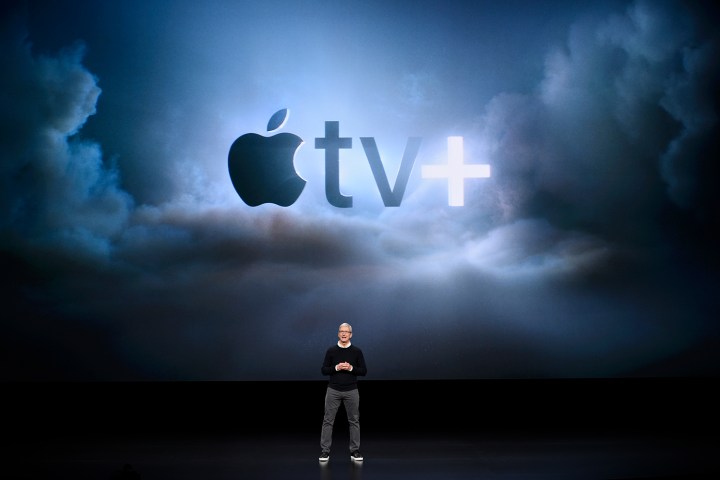
As anticipated, Apple’s “It’s show time” event was a shiny showcase outlining its plan to push away from reliance on hardware and devices and toward its already-lucrative services business.
The new services hit the Cupertino, CA stage in a kaleidoscope of mediums, including a news bundle encompassing 300 magazine subscriptions for just $10 per month, a full revamp of its Apple TV app that bundles multiple premium channels and streaming services into one place, and a new Netflix-style streamer of original programming called Apple Plus. In addition, Apple showed off its new gaming service, Apple Arcade and — because why not? — even a new fancy credit card tied to Apple Pay that’s made from titanium and backed by Goldman Sachs.
The whirlwind event was headlined by some of the world’s most powerful celebrities and storytellers, from Jennifer Aniston to Steven Spielberg. The underlying message: Apple’s massive software revamp is essentially designed to snare its oft-referenced billion users in a web of news and TV content that will keep them fused to Apple’s servers for the rest of their news-reading, game-playing, and TV-streaming days.
One ton of magazines, one great price
Apple seems to have put its best foot forward at today’s event, revealing perhaps its most appealing new service (and the only one with an actual price tag) first. Apple News Plus offers an impressive collection of magazine subscriptions into one service from publishers like National Geographic and Popular Science to Marie Claire and Essence, as well as newspapers like the LA Times and the Wall Street Journal — all for just 10 bucks.

In typical Apple fashion, the service’s visual presentation looks beautiful, with Harry Potter-style moving pictures for the covers and a promise of Apple’s personalized curation to get you the content you want. An easy-to-navigate interface takes you directly to each magazine’s table of contents to browse and peruse their latest issues, and with so much to choose from at such a low price, this could be the best new service of the bunch.
Didn’t Amazon do that?
As for the much-heralded Apple TV streaming service, as expected, we got a sort of mixed-bag offering, including an update to Apple’s tvOS app that will bundle around 150 streaming apps/services under the company’s software umbrella, alongside a Netflix-style streaming service with original content from a flurry of Hollywood’s top storytellers (more on the latter below).
Frankly, this doesn’t feel all that different from what Hulu and Amazon are already doing.
Speaking of Netflix, the Apple TV revamp, which arrives in May, won’t include the big red streamer. Instead, you’ll see premium channels like HBO and Showtime as well as apps for live TV services like Playstation Vue, FuboTV, and even pay TV providers like DirecTV.
We don’t know what these services will cost when you sign up through Apple — or if there will be any discount at all — but we do know that at least a portion of the content will be downloadable and ad-free, and it will eventually roll out to both Apple and non-Apple devices, including smart TVs from brands like Samsung and LG as well as Roku and Fire TV streaming devices.
Frankly, this doesn’t feel all that different from what Hulu and Amazon are already doing, allowing users to add premium channels to their streaming service at an additional cost, but with more choices. One thing that may be appealing for heavy Apple users is the ability to authenticate all these apps from one device. But if there’s no discount, we’re not sure this will be much more useful to those who already have these apps on their Roku or Fire TV devices.
Yet another “Plus”
The other side of Apple’s new streaming coin, Apple TV Plus, feels even less distinctive save for its long list of new titles in the works. Apart from its celebrity pedigree, Apple’s new service appears to mirror closely the gobs of other streaming services now available, beginning with a name that (as with its Apple News service) borrows from a moniker already snagged by Disney for its ESPN Plus and Disney Plus streamers.

Arriving this fall for an unknown monthly fee, Apple Plus’ biggest selling point appears to be the long list of very big names tapped to build out content, many of whom were present on Apple’s big black stage for bragging rights. Those names include Mr. Spielberg himself, JJ Abrams, Oprah Winfrey, and a ton of other mega-celebs like Jennifer Aniston and Steve Carell. While there are some compelling shows on the list, including the Carell-starring The Morning Show and Spielberg’s revamp of Amazing Stories, there isn’t much else that raises this service above the waves at first glance.
Apple Plus’ biggest selling point appears to be the long list of very big names tapped to build out content.
For example, it’ll be interesting to see Spielberg’s new take on his beloved ‘80s sci-fi anthology, but will it be any more interesting than Jordan Peele’s new Twilight Zone from the increasingly intriguing CBS All Access streamer? The same goes for Carell’s new show — it sounds fun, but there are tons of comedies to stream all over the web, and when it comes to generating excitement it certainly doesn’t compare to what Disney’s new streamer is bringing with shows featuring Marvel’s Loki and Winter Soldier, and starring the same Hollywood bigwigs who play those characters in the box office-busting films.
Starting this late in the game — and without the watershed of powerful intellectual properties owned by the Disney monolith, or the seemingly infinite titles mass produced by the colossal Netflix machine — Apple’s new service has a tough road ahead to distinguish itself from the sprawling field of streamers that’s growing by the minute, each one vying for your dollars. Apple is instead banking that, like its Spotify competitor, Apple Music, the combination of Apple Plus’ big names and the convenience of its availability on your iPhone or iPad will be enough.
New games and a fancy card
The other new additions to Apple’s service-bundling machine include a new gaming service with some aesthetically unique exclusive titles called Apple Arcade (Google Stadia, anyone?) as well as a new credit card tied to Apple Pay called (you guessed it) Apple Card that’s made from titanium, backed by Goldman Sachs, and doesn’t have a CVV number (that little three-digit code) outside of the Wallet app. The card promises “low interest” and “no penalty rate” or fees if you pay late, as well as a cash back system with incentives to buy Apple products or use Apple Pay. Frankly, I’ll take the Amazon credit card, but maybe that’s just me.

As has often been the case of late, there’s not much unique or distinctive here, just the content, services, and bundles you already know, but in Apple’s hands. Somewhat ironically, as the company is pushing deeper into services to offset slowing device sales, it’s also relying heavily on those same devices in hands across the world to get you hooked on its new bundles.
It’s worked before. Apple Music has come impressively close to matching Spotify when it comes to subscribers, even though Spotify had a multi-year head start. What’s more, this conservative approach could allow Apple to test what works and what doesn’t as it builds out these new services for new advancements in the future.
But if you’re looking for something new and revolutionary, rather than altered and evolutionary, you’re barking up the wrong tree. That Apple doesn’t seem to live here anymore.
Editors' Recommendations
- Apple TV with Zoom means it’s finally time to call your mother
- MLS Season Pass on Apple TV shows everyone else how to stream sports
- Apple TV gets FaceTime integration and Spatial Audio
- Trailer for M. Night Shyamalan and Apple TV+’s Servant gives away the big twist
- Disney bans Netflix, Amazon vanishes from Apple: Welcome to the streaming wars


